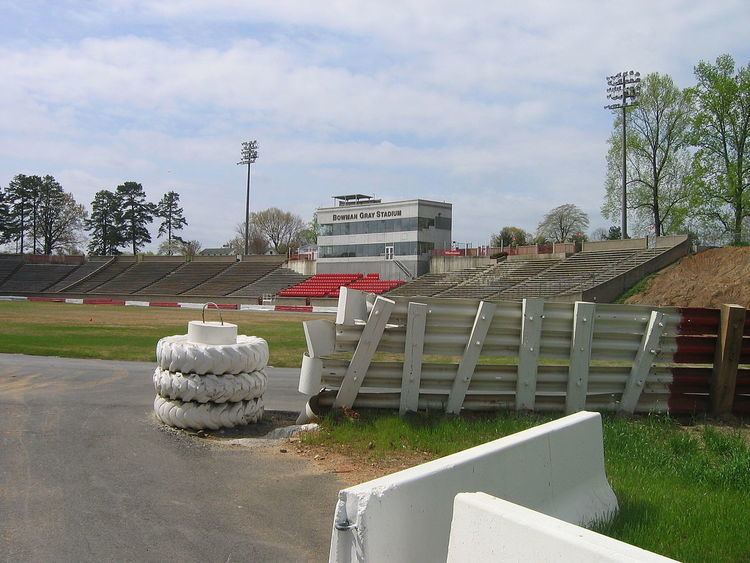Owner City of Winston-Salem Broke ground 1936 Opened 1937 Phone +1 336-725-5635 | Operator Gray Garrison Surface Asphalt Capacity 17,000 | |
 | ||
Major events NASCAR Grand National (1958-1971)NASCAR K&N Pro Series East (2011-2015)Whelen Southern Modified Tour Address 1250 S Martin Luther King Jr, Winston-Salem, NC 27107, USA Similar Hickory Motor Speedway, Langley Speedway, BB&T Field, Lawrence Joel Veterans, Reynolda House Museum | ||
Racecar retaliation after crash at bowman gray stadium
Bowman Gray Stadium is a NASCAR sanctioned 1⁄4-mile (0.40 km) asphalt flat oval short track and longstanding football stadium located in Winston-Salem, North Carolina. It is one of stock car racing's most legendary venues, and is referred to as "NASCAR's longest-running weekly race track". Bowman Gray Stadium is part of the Winston-Salem Sports and Entertainment Complex and is home of the Winston-Salem State University Rams football team. It was also the home of the Wake Forest University football team from 1956 until Groves Stadium (later BB&T Field) opened in 1968. Bowman Gray Stadium was a popular venue for high school football in the 1970s and 1980s. Parkland and R.J. Reynolds High Schools shared Bowman Gray Stadium as their home field for high school football until the two schools built their own facility (Deaton-Thompson Stadium) in 1994.
Contents
- Racecar retaliation after crash at bowman gray stadium
- Big crash bowman gray stadium aug 13 2016
- History
- Today
- Track champions
- References
Big crash bowman gray stadium aug 13 2016
History
The first NASCAR-sanctioned event took place on May 18, 1949 and was won by Fonty Flock. The track was opened by NASCAR founder Bill France Sr. and Alvin Hawkins, and remains operated by members of the Hawkins family to this day. In 2015, Bowman Gray celebrated its 1,000th NASCAR sanctioned race
The first Grand National (now Sprint Cup Series) event took place in 1958 and it was won by Bob Welborn. Other winners include Glen Wood, Rex White, David Pearson, Richard Petty, Bobby Allison, Junior Johnson and Marvin Panch. The Grand National Series first raced at the track in 1958 and hosted a total of 29 Grand National races through 1971.
Bowman Gray's nickname, the "Madhouse," is largely attributed to the racing antics that take place on the tight, quarter mile bull ring. In 2014, Bowman Gray's promoter, Gray Garrison described the events at BGS as part racing, part religion, and part wrestling. While this is partially the reason for the nickname, it actually originated from a qualifying format the track used in the 1950s called the "mad scramble."
Currently, the track features four divisions: the modifieds, sportsman, street stock and stadium stock. The modifieds are the featured division at Bowman Gray, the division started in 1949 and the all-time wins list features some of the best NASCAR drivers including Lee Petty, Ralph Earnhardt, Ned Jarrett, Richie Evans, and Jerry Cook.
The football history of the stadium is also quite storied. Wake Forest University played home games in the stadium from its move to Winston-Salem in 1956, until the 1968 season when Groves Stadium (now BB&T Field) opened. Players such as Brian Piccolo, the 1964 ACC Player of the Year who led the nation in rushing and scoring, played his home games in Bowman Gray. Piccolo later became famous as the teammate of Gale Sayers with the Chicago Bears, and the subject of the 1971 film Brian's Song. The Winston-Salem high schools of R.J.Reynolds High and Parkland High also played their home games at the stadium in the late 1960s through 1980's.
Today
Bowman Gray's weekly racing tradition continues as part of the Whelen All-American Series, with races Saturday evenings from the end of April through August.
Weekly races include the modified, sportsman, street stock and stadium stock divisions. Bowman Gray is also a part of the special events including classic modified coupes and East Coast Flathead Ford Racing Association (ECFFRA), monster trucks, demolition derbies, chain races, skid races and INEX Legends Car and bandolero races. The History Channel show MadHouse was taped at the track during the 2009 season. The showed aired in January 2010 and ran through April 2010.
Spectators listen to the officials during the races on frequencies 461.200 MHz, 463.625 MHz, and 466.600 MHz on a scanner or "race radio." Many, if not all of the drivers also communicate via a two-way radio during the race. Most of them use a frequency between 450-470 MHz, but there are exceptions.
Track champions
Modified and sportsman car counts were thin during the latter part of the 1950s and the track combined the two and let the V6s run with the V8s and named it the "Modified-Sportsman Division". Leading into the 1968 season, the track dropped the sportsman cars and title, hence officially named the featured division as the modifieds.
The Amateur Division was the support division to the modified-sportsman and ran from 1950 to mid-1958, where the division dissolved and the track picked up the Hobby Division.
The Claiming Division was tabbed as a third weekly division in 1964. It was a division that cost only $99 to run, it was so popular that the track had to cut the fields down to two races with ten cars apiece. The division ran from 1964 to 1972. The track changed the name to what is now the Sportsman Division.
The Hobby Division, which was the predecessor of the Street Stock Division, ran from mid-1958 to 1974. Then the following year, the division was renamed to the street stock.
Bowman Gray ran Blunderbust races as a fourth division from 1977-1989 until they replaced that division with the Buzzbomber Division in 1990. The following season, the track kept the cars, but changed the division to what is now the Stadium Stock Division.
